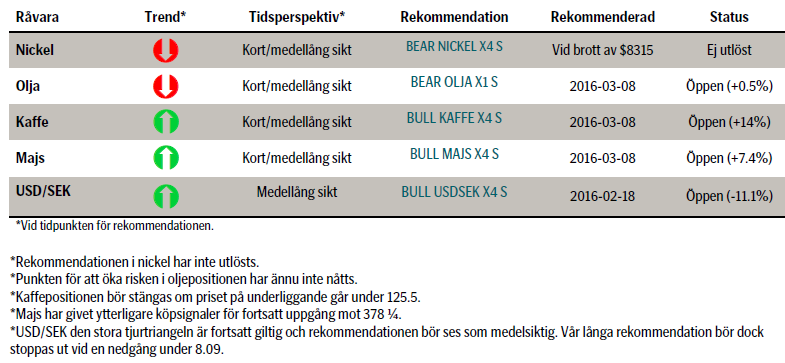Analys
SEB Råvarubrev 30 mars 2016

 Inget stöd från den svagare dollarn.
Inget stöd från den svagare dollarn.
MARKNADEN I KORTHET
Efter att vissa FED ledamöter under förra veckan uttryckt sig något mer hökaktigt så plockade Yellen igår kväll effektivt ned förväntningar om en sådan utveckling. Talet var i stort sett en upprepning av budskapet från FEDs marsmöte. Dollarn föll följaktligen tillbaka efter talet. Det är dock intressant att notera att flera råvaror inte dragit nytta av dollarförsvagningen vilket vi anser stärka vår vy om svagare basmetaller och olja. Det faktum att det statliga specialstålbolaget Dongbei Special Steel missade en räntebetalning på sitt obligationslån (första gången ett statligt bolag missar en räntebetalning på en listad obligation) visar på de fortsatta problem stålindustrin står inför.
Råvaror: Olja och basmetaller kämpar för närvarande i motvind medan jordbruksprodukter klarat sig bättre.
Valuta: Dollarn faller antagligen något ytterligare innan vi når fast mark.
Börser: Fortsätter att utvecklas positivt ledda av USA. Bankaktier fortsätter dock att vara ett sänke.
Räntor: Centralbankernas agerande fortsätter att pressa ned de långa räntorna.
OBSERVATIONER I SAMMANDRAG
- Brentoljan ser nu ut att ha satt åtminstone en temporär topp på plats.
- Elpriset har tagit ett kliv uppåt och nu nått vårt säljområde.
- Försöket till en dollarbotten kom av sig efter Yellen. Ett nytt försök bör komma inom kort.
- Koppar ser allt svagare ut och vi ser en klar risk för ytterligare nedgång i närtid.
- Nickel närmar sig nu den säljnivå vi pekat ut under de senaste veckorna.
- Dollarsäljarna har visat sig vara mer envisa än vad vi förutsett (stopp under 8,09)
- Guldet har nått ett minimimål för korrektionen men inte med mindre än ett brott över $1271/uns blir vi positiva. Vi anser att marknaden är fortsatt allt för överköpt för att kunna fortsätta uppgången just nu.
- Kaffet har korrigerat kraftigare än förväntat men vi är kvar långa så länge inte $125,5 bryts.
VECKANS REKOMMENDATIONER
En placering i certifikat och warranter är förknippat med risker. Du kan förlora hela ditt investerade kapital. Läs mer om riskerna i SEB:s offentliggjorda Grundprospekt för certifikat- och warrantprogram på seb.se/cert eller seb.se/mini
OLJA BRENT
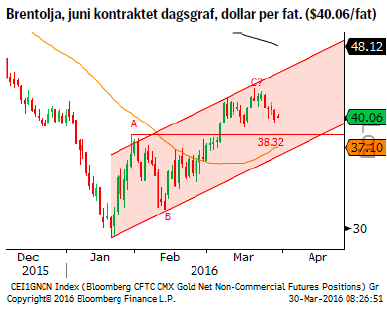 Än så länge så ser det ut som vårt antagande om en (åtminstone temporär) pristopp varit korrekt då förra veckan slutade netto ned för första gången på sex veckor. Den spekulativa netto långa nettopositioneringen fortsatte dock att öka och är nu den högsta sedan juni 2015 (inte långt från förra årets korrektionstopp). Dollarindex stärktes också under förra veckan vilket även det hjälpte till med att guida priset lägre. Fokus kommande veckor är fortsatt på det uppkommande oljeproducent mötet i Doha den 17:e april.
Än så länge så ser det ut som vårt antagande om en (åtminstone temporär) pristopp varit korrekt då förra veckan slutade netto ned för första gången på sex veckor. Den spekulativa netto långa nettopositioneringen fortsatte dock att öka och är nu den högsta sedan juni 2015 (inte långt från förra årets korrektionstopp). Dollarindex stärktes också under förra veckan vilket även det hjälpte till med att guida priset lägre. Fokus kommande veckor är fortsatt på det uppkommande oljeproducent mötet i Doha den 17:e april.
Vi har en negativ vy även för innevarande vecka.
OBSERVATIONER
- Antalet riggar föll igen (-15) igen efter förr förra veckans uppgång och uppgår nu till 372 stycken.
- Gårdagens dollarnedgång gav inte mycket till stöd för oljepriset vilket vi ser som en negativ faktor.
- Lagren fortsätter att stiga (vilket ger incitament att ställa av ytterligare borriggar). Lagren har ökat med 32 miljoner fat bara de senaste fyra veckorna.
- Commitment of Traders (CoT) rapporten visar på fortsatt spekulativt köpande.
- Köpandet är dock i huvudsak stängningar av korta positioner och inte nya långa positioner.
- CoT-positioneringen närmar sig de långa nivåer som vi såg vid förra årets korrektionstopp (Brentpositioneringen är den högsta någonsin).
- Det historiska säsongsmönstret pekar mot en pristopp under våren,
- $38.96 och $38.32/fat är veckans viktigaste stödpunkter.
- $41.62/fat är ett viktigt motstånd.
REKOMMENDATION
- BEAR OLJA X1 S (vi rekommenderar att öka hävstång om/när priset faller under $36,25/fat).
EL
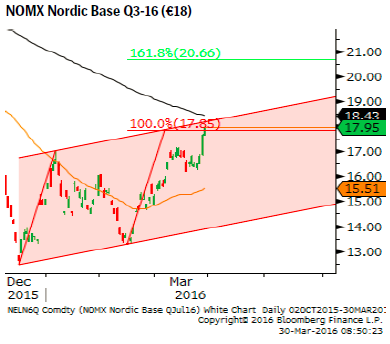 Efter den senaste prisuppgången så har vi hamnat i det område, €17.35 – 18.45 som vi primärt ser som ett målområde för innevarande uppgång. Divergensen mellan olja och el är relativt stor och bör sannolikt inte öka ytterligare. Ett stigande kolpris borde ge stöd men neutraliseras i princip av lägre CO2 priser.
Efter den senaste prisuppgången så har vi hamnat i det område, €17.35 – 18.45 som vi primärt ser som ett målområde för innevarande uppgång. Divergensen mellan olja och el är relativt stor och bör sannolikt inte öka ytterligare. Ett stigande kolpris borde ge stöd men neutraliseras i princip av lägre CO2 priser.
OBSERVATIONER
- Befinner sig nu i det utmålade målområdet €17.35 – 18.45.
- Inflödet till vattenmagasinen fortsätter att öka varefter våren framskrider.
- Vattenmagasinen har sedan förra veckan minskat något och har nu en fyllnadsgrad på 43.5%. Fyllnadsgraden bör minska ytterligare då man nu tappar av för att ge plats för vårfloden.
- Hydrobalansen har ett något större underskott (-7 TWh) jämfört med förra veckan (-5,3 Twh).
- Den meterologiska prognosen säger att vi har torrare väder än normalt att förvänta (under en under året torr period).
- Kanaltaket och 200-dagars medelvärdet utgår två viktiga tekniska motstånd.
- Skulle priset mot förmodan inte vända i det primära målområdet så återfinns ett sekundärt mål vid €20.66.
REKOMMENDATION
- BEAR EL X2 S
KOPPAR (LME 3M)
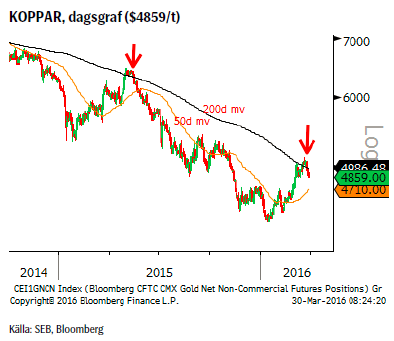 För det första så är hela metallkomplexet för närvarande på tillbakagång (fortsättning av nedåttrend eller korrektion av årets uppgång). För det andra så tillhör koppar och aluminium de två metaller som ser svagast ut och därför bör drabbas hårdast den närmaste tiden. Det kinesiska köpandet av koppar förväntas minska framgent då arbitraget att köpa koppar ur LMEs lager och sälja motsvarande koppar på Shanghaibörsen nu ser ut att komma till sitt slut då skillnaden i pris nu utjämnas. Kinesiska importörer har också köpt för lager utifall att den kinesiska valutan skulle komma att devalveras. Noterbart är också att trots dollarns fall efter Yellens tal igår kväll föll ändå kopparpriset.
För det första så är hela metallkomplexet för närvarande på tillbakagång (fortsättning av nedåttrend eller korrektion av årets uppgång). För det andra så tillhör koppar och aluminium de två metaller som ser svagast ut och därför bör drabbas hårdast den närmaste tiden. Det kinesiska köpandet av koppar förväntas minska framgent då arbitraget att köpa koppar ur LMEs lager och sälja motsvarande koppar på Shanghaibörsen nu ser ut att komma till sitt slut då skillnaden i pris nu utjämnas. Kinesiska importörer har också köpt för lager utifall att den kinesiska valutan skulle komma att devalveras. Noterbart är också att trots dollarns fall efter Yellens tal igår kväll föll ändå kopparpriset.
OBSERVATIONER
- Arbitraget att flytta koppar till Kina minskar.
- Lageruppbyggnad i Kina pga. oro för CNY-försvagning.
- Dollarkorrektionens sista fas?
- Den långa nettopositioneringen gör att marknaden är sårbar för ett fallande pris (stopp loss försäljningar).
- Kapitalförvaltare har de två senaste veckorna minskat sin långa kopparposition.
- Prisuppgången i år kan inte motiveras av förändrade utbuds/efterfrågekalkyler (Goldman Sachs ser t.ex. inte marknaden i balans förrän 2019).
- Tekniskt så har vi precis återvänt ned under ett negativt lutat 200-dagars glidande medelvärde, precis så som korrektionen 2015 slutade.
REKOMMENDATION
- BEAR KOPPAR X4 S
NICKEL (LME 3M)
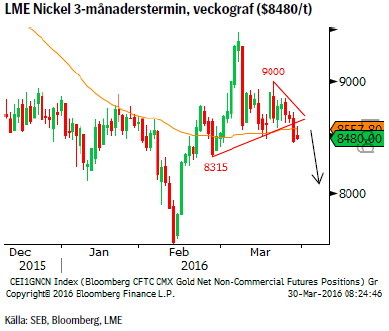 Nickelpriset befann sig förra veckan i ett relativt snävt intervall konsoliderandes det tidigare kraftiga prisfallet. Vår vy är fortfarande att priset ska ned ytterligare i närtid och det trots att prognoserna pekar på att marknaden kommer att hamna i underskott tidigare än förväntat. Noterbart är också att trots dollarns fall efter Yellens tal igår kväll föll ändå nickelpriset.
Nickelpriset befann sig förra veckan i ett relativt snävt intervall konsoliderandes det tidigare kraftiga prisfallet. Vår vy är fortfarande att priset ska ned ytterligare i närtid och det trots att prognoserna pekar på att marknaden kommer att hamna i underskott tidigare än förväntat. Noterbart är också att trots dollarns fall efter Yellens tal igår kväll föll ändå nickelpriset.
OBSERVATIONER
- INSG’s (Int’l Nickel Study Group) senaste rapport om ett underskott om 8,100 ton redan i januari indikerar att vi snabbare än förväntat hamnat i underskott.
- Det globala underskottet förväntas att förvärras under kvartal 2.
- Prisutvecklingen visar dock att marknaden tar underskottet med ro och revideringar av data är antagligen också att förvänta.
- Data för januari är ofta föremål för revideringar då inkommande data ofta är försenat pga. det kinesiska nyåret.
- Svaghet inom rostfritt stål och än så länge bara planerade, inte genomförda, produktionsneddragningar bör dämpa försök till prisuppgångar.
- Tekniskt är konsolideringen de senaste veckorna ett fortsättningsmönster för nedsidan ($8315/ton måste dock brytas för att bekräfta nästa steg nedåt).
REKOMMENDATION
- BEAR NICKEL X4 S vid ett brott av $8315/t.
GULD
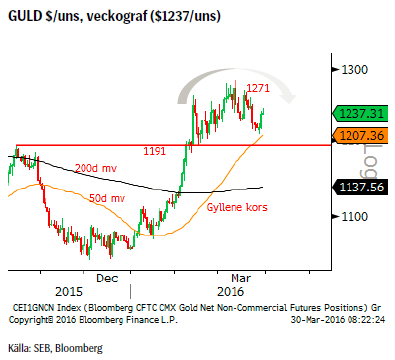 Guldpriset fortsatte förra veckan att glida nedåt och ett minimimål, $1212/uns, har också uppnåtts. Vi håller dock kvar vår vy att priset bör falla under $1200/uns (idealet är $1191/uns) innan ett nytt försök mot högre nivåer görs. Marknaden adderade, trots nedgången i pris, ytterligare långa positioner och nettopositioneringen är nu den största sedan januari 2015 vilket vi fortsatt ser som en nedåtrisk. Centralbanker i öst fortsätter att köpa guld i stor skala (Ryssland ska enligt IMF ha adderat ytterligare 356,000 uns under februari, även Kina sägs ha gjort så men där saknas data hos IMF).
Guldpriset fortsatte förra veckan att glida nedåt och ett minimimål, $1212/uns, har också uppnåtts. Vi håller dock kvar vår vy att priset bör falla under $1200/uns (idealet är $1191/uns) innan ett nytt försök mot högre nivåer görs. Marknaden adderade, trots nedgången i pris, ytterligare långa positioner och nettopositioneringen är nu den största sedan januari 2015 vilket vi fortsatt ser som en nedåtrisk. Centralbanker i öst fortsätter att köpa guld i stor skala (Ryssland ska enligt IMF ha adderat ytterligare 356,000 uns under februari, även Kina sägs ha gjort så men där saknas data hos IMF).
Vi bibehåller förra veckas rekommendation att gå lång vid en dipp under $1200/uns.
OBSERVATIONER
- Dollarförsvagningen bör vara i sin slutfas trots Yellens idoga försök att spela ned förväntningar om räntehöjningar.
- Flödet in i guldrelaterade aktier och produkter har fortsatt.
- Centralbanker i öst fortsätter att köpa (och i väst att sälja t.ex. Bank of Canada har sålt av hela sitt innehav).
- CoT (Commitment of Traders) rapporten visade att de spekulativa köparna förra veckan kom tillbaka.
- CoT positioneringen är nu den högsta på 14 månader.
- Guldsmedsstrejken (mot höjning av punktskatten på ädelmetaller) i Indien är över vilket kan tänkas öka aktiviteten.
- Tekniskt bör vi hålla oss under $1271/uns för att möjligheten till den sökta nedgången ska kvarstå.
- Tekniskt så skulle även en så kallad huvud/skuldra toppformation kunna vara i görande.
REKOMMENDATION
- BULL GULD X2 S när priset går under $1200.
KAFFE
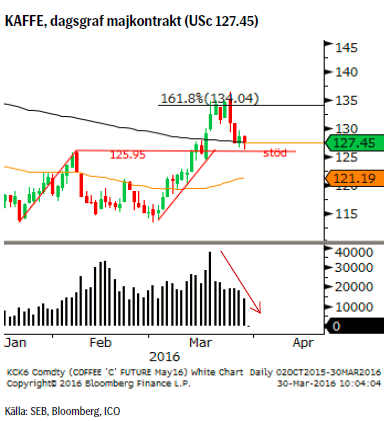 Kaffepriset förra veckan var som vi fruktade allt för högt och marknaden allt för överköpt. Korrektionen, driven av vinsthemtagningar, blev dock kraftigare än vad vi räknat med. Med underliggande fundamentala faktorer talandes för högre priser samt att volymen fallit kraftigt under korrektionen kvarstår vår positiva vy. Idealt ska priset nu börja stiga från stödet vid $125.95 – 127.49.
Kaffepriset förra veckan var som vi fruktade allt för högt och marknaden allt för överköpt. Korrektionen, driven av vinsthemtagningar, blev dock kraftigare än vad vi räknat med. Med underliggande fundamentala faktorer talandes för högre priser samt att volymen fallit kraftigt under korrektionen kvarstår vår positiva vy. Idealt ska priset nu börja stiga från stödet vid $125.95 – 127.49.
OBSERVATIONER
- ICO pekade i sin senaste rapport på ett ökat skördeunderskott i år.
- Osäkerheten är dock stor hur mycket som kan kompenseras via ”okända” lager.
- Det politiska läget i Brasilien förvärras hela tiden vilket kan komma att ge störningar i både utbud och utskeppning.
- El Niňo har gjort att växterna generellt är i sämre skick och därför förväntas ge en mindre avkastning.
- El Niňo klingar allt tydligare av (havsytetemperaturen i Stilla havet har på några månader fallit med cirka 1.5 grad (av de 3 graders uppgång som fenomenet orsakat).
REKOMMENDATION
- BULL KAFFE X4 S – stopp under 125.5.
AKTUELLA REKOMMENDATIONER
[box]SEB Veckobrev Veckans råvarukommentar är producerat av SEB:s Commodities Sales desk och publiceras i samarbete och med tillstånd på Råvarumarknaden.se[/box]
KÄLLOR
Bloomberg, Reuters, SEB
VILLKOR
För varje enskilt certifikat/mini future finns Slutliga Villkor som anger de fullständiga villkoren. Slutliga Villkor finns tillgängligt på kurssidan för respektive certifikat/mini future på www.seb.se, Börs & finans, fliken Strukturerade placeringar.
RISKER
En sammanfattning av de risker som är förknippade med Börshandlade certifikat generellt finns i Produktbroschyren för respektive certifikat eller mini future som är tillgängligt på seb.se/cert respektive seb.se/mini. För en fullständig bild av riskerna behöver du ta del av SEB:s offentliggjorda Grundprospekt för Certifikat- och Warrantprogram som är publicerat på www.seb.se/cert respektive seb.se/mini.
DISCLAIMER
Detta marknadsföringsmaterial, framtaget av SEB:s Commodities Sales desk, har upprättats enbart i informationssyfte.
Även om innehållet är baserat på källor som SEB bedömt som tillförlitliga ansvarar SEB inte för fel eller brister i informationen. Den utgör inte oberoende, objektiv investeringsanalys och skyddas därför inte av de bestämmelser som SEB har infört för att förebygga potentiella intressekonflikter. Yttranden från SEB:s Commodities Sales desk kan vara oförenliga med tidigare publicerat material från SEB, då den senare hänvisas uppmanas du att läsa den fullständiga rapporten innan någon åtgärd vidtas.
Dokumentationen utgör inte någon investeringsrådgivning och tillhandahålls till dig utan hänsyn till dina investeringsmål. Du uppmanas att självständigt bedöma och komplettera uppgifterna i denna dokumentation och att basera dina investeringsbeslut på material som bedöms erforderligt. Alla framåtblickande uttalanden, åsikter och förväntningar är föremål för risker, osäkerheter och andra faktorer och kan orsaka att det faktiska resultatet avviker väsentligt från det förväntade. Historisk avkastning är ingen garanti för framtida resultat. Detta dokument utgör inte ett erbjudande att teckna några värdepapper eller andra finansiella instrument. SEB svarar inte för förlust eller skada – direkt eller indirekt, eller av vad slag det vara må – som kan uppkomma till följd av användandet av detta material eller dess innehåll.
Observera att det kan förekomma att SEB, dess ledamöter, dess anställda eller dess moder- och/eller dotterbolag vid olika tillfällen innehar, har innehaft eller kommer att inneha aktier, positioner, rådgivningsuppdrag i samband med corporate finance-transaktioner, investment- eller merchantbanking-uppdrag och/eller lån i de bolag/finansiella instrument som nämns i materialet.
Materialet är avsett för mottagaren, all spridning, distribuering mångfaldigande eller annan användning av detta meddelande får inte ske utan SEB:s medgivande. Materialet riktar sig inte till personer vars medverkan kräver ytterligare prospekt, registrerings- eller andra åtgärder än vad som följer av svensk rätt. Det åligger var och en att iaktta sådana restriktioner. Materialet får inte distribueras i eller till land där distribution kräver ovan nämnda åtgärder eller strider mot reglering i sådant land. Materialet riktar sig således inte till fysiska eller juridiska personer hemmahörande i USA eller i något annat land där publicering eller tillhandahållande av materialet är förbjudet eller strider mot tillämpliga bestämmelser i landet.
Oaktat detta får SEB tillåta omfördelning av materialet till utvald tredje part i enlighet med gällande avtal. Materialet får inte spridas till fysiska eller juridiska personer som är medborgare eller har hemvist i ett land där sådan spridning är otillåten enligt tillämplig lag eller annan bestämmelse.
Skandinaviska Enskilda Banken AB (publ) är ett publikt aktiebolag och står under tillsyn av Finansinspektionen samt de lokala finansiella tillsynsmyndigheter i varje jurisdiktionen där SEB har filial eller dotterbolag.
Analys
Tightening fundamentals – bullish inventories from DOE

The latest weekly report from the US DOE showed a substantial drawdown across key petroleum categories, adding more upside potential to the fundamental picture.

Commercial crude inventories (excl. SPR) fell by 5.8 million barrels, bringing total inventories down to 415.1 million barrels. Now sitting 11% below the five-year seasonal norm and placed in the lowest 2015-2022 range (see picture below).
Product inventories also tightened further last week. Gasoline inventories declined by 2.1 million barrels, with reductions seen in both finished gasoline and blending components. Current gasoline levels are about 3% below the five-year average for this time of year.
Among products, the most notable move came in diesel, where inventories dropped by almost 4.1 million barrels, deepening the deficit to around 20% below seasonal norms – continuing to underscore the persistent supply tightness in diesel markets.
The only area of inventory growth was in propane/propylene, which posted a significant 5.1-million-barrel build and now stands 9% above the five-year average.
Total commercial petroleum inventories (crude plus refined products) declined by 4.2 million barrels on the week, reinforcing the overall tightening of US crude and products.


Analys
Bombs to ”ceasefire” in hours – Brent below $70

A classic case of “buy the rumor, sell the news” played out in oil markets, as Brent crude has dropped sharply – down nearly USD 10 per barrel since yesterday evening – following Iran’s retaliatory strike on a U.S. air base in Qatar. The immediate reaction was: “That was it?” The strike followed a carefully calibrated, non-escalatory playbook, avoiding direct threats to energy infrastructure or disruption of shipping through the Strait of Hormuz – thus calming worst-case fears.

After Monday morning’s sharp spike to USD 81.4 per barrel, triggered by the U.S. bombing of Iranian nuclear facilities, oil prices drifted sideways in anticipation of a potential Iranian response. That response came with advance warning and caused limited physical damage. Early this morning, both the U.S. President and Iranian state media announced a ceasefire, effectively placing a lid on the immediate conflict risk – at least for now.
As a result, Brent crude has now fallen by a total of USD 12 from Monday’s peak, currently trading around USD 69 per barrel.
Looking beyond geopolitics, the market will now shift its focus to the upcoming OPEC+ meeting in early July. Saudi Arabia’s decision to increase output earlier this year – despite falling prices – has drawn renewed attention considering recent developments. Some suggest this was a response to U.S. pressure to offset potential Iranian supply losses.
However, consensus is that the move was driven more by internal OPEC+ dynamics. After years of curbing production to support prices, Riyadh had grown frustrated with quota-busting by several members (notably Kazakhstan). With Saudi Arabia cutting up to 2 million barrels per day – roughly 2% of global supply – returns were diminishing, and the risk of losing market share was rising. The production increase is widely seen as an effort to reassert leadership and restore discipline within the group.
That said, the FT recently stated that, the Saudis remain wary of past missteps. In 2018, Riyadh ramped up output at Trump’s request ahead of Iran sanctions, only to see prices collapse when the U.S. granted broad waivers – triggering oversupply. Officials have reportedly made it clear they don’t intend to repeat that mistake.
The recent visit by President Trump to Saudi Arabia, which included agreements on AI, defense, and nuclear cooperation, suggests a broader strategic alignment. This has fueled speculation about a quiet “pump-for-politics” deal behind recent production moves.
Looking ahead, oil prices have now retraced the entire rally sparked by the June 13 Israel–Iran escalation. This retreat provides more political and policy space for both the U.S. and Saudi Arabia. Specifically, it makes it easier for Riyadh to scale back its three recent production hikes of 411,000 barrels each, potentially returning to more moderate increases of 137,000 barrels for August and September.
In short: with no major loss of Iranian supply to the market, OPEC+ – led by Saudi Arabia – no longer needs to compensate for a disruption that hasn’t materialized, especially not to please the U.S. at the cost of its own market strategy. As the Saudis themselves have signaled, they are unlikely to repeat previous mistakes.
Conclusion: With Brent now in the high USD 60s, buying oil looks fundamentally justified. The geopolitical premium has deflated, but tensions between Israel and Iran remain unresolved – and the risk of missteps and renewed escalation still lingers. In fact, even this morning, reports have emerged of renewed missile fire despite the declared “truce.” The path forward may be calmer – but it is far from stable.
Analys
A muted price reaction. Market looks relaxed, but it is still on edge waiting for what Iran will do

Brent crossed the 80-line this morning but quickly fell back assigning limited probability for Iran choosing to close the Strait of Hormuz. Brent traded in a range of USD 70.56 – 79.04/b last week as the market fluctuated between ”Iran wants a deal” and ”US is about to attack Iran”. At the end of the week though, Donald Trump managed to convince markets (and probably also Iran) that he would make a decision within two weeks. I.e. no imminent attack. Previously when when he has talked about ”making a decision within two weeks” he has often ended up doing nothing in the end. The oil market relaxed as a result and the week ended at USD 77.01/b which is just USD 6/b above the year to date average of USD 71/b.

Brent jumped to USD 81.4/b this morning, the highest since mid-January, but then quickly fell back to a current price of USD 78.2/b which is only up 1.5% versus the close on Friday. As such the market is pricing a fairly low probability that Iran will actually close the Strait of Hormuz. Probably because it will hurt Iranian oil exports as well as the global oil market.
It was however all smoke and mirrors. Deception. The US attacked Iran on Saturday. The attack involved 125 warplanes, submarines and surface warships and 14 bunker buster bombs were dropped on Iranian nuclear sites including Fordow, Natanz and Isfahan. In response the Iranian Parliament voted in support of closing the Strait of Hormuz where some 17 mb of crude and products is transported to the global market every day plus significant volumes of LNG. This is however merely an advise to the Supreme leader Ayatollah Ali Khamenei and the Supreme National Security Council which sits with the final and actual decision.
No supply of oil is lost yet. It is about the risk of Iran closing the Strait of Hormuz or not. So far not a single drop of oil supply has been lost to the global market. The price at the moment is all about the assessed risk of loss of supply. Will Iran choose to choke of the Strait of Hormuz or not? That is the big question. It would be painful for US consumers, for Donald Trump’s voter base, for the global economy but also for Iran and its population which relies on oil exports and income from selling oil out of that Strait as well. As such it is not a no-brainer choice for Iran to close the Strait for oil exports. And looking at the il price this morning it is clear that the oil market doesn’t assign a very high probability of it happening. It is however probably well within the capability of Iran to close the Strait off with rockets, mines, air-drones and possibly sea-drones. Just look at how Ukraine has been able to control and damage the Russian Black Sea fleet.
What to do about the highly enriched uranium which has gone missing? While the US and Israel can celebrate their destruction of Iranian nuclear facilities they are also scratching their heads over what to do with the lost Iranian nuclear material. Iran had 408 kg of highly enriched uranium (IAEA). Almost weapons grade. Enough for some 10 nuclear warheads. It seems to have been transported out of Fordow before the attack this weekend.
The market is still on edge. USD 80-something/b seems sensible while we wait. The oil market reaction to this weekend’s events is very muted so far. The market is still on edge awaiting what Iran will do. Because Iran will do something. But what and when? An oil price of 80-something seems like a sensible level until something do happen.
-

 Nyheter3 veckor sedan
Nyheter3 veckor sedanStor uppsida i Lappland Guldprospekterings aktie enligt analys
-

 Nyheter4 veckor sedan
Nyheter4 veckor sedanBrookfield ska bygga ett AI-datacenter på hela 750 MW i Strängnäs
-

 Nyheter4 veckor sedan
Nyheter4 veckor sedanSommaren inleds med sol och varierande elpriser
-

 Nyheter3 veckor sedan
Nyheter3 veckor sedanSilverpriset släpar efter guldets utveckling, har mer uppsida
-

 Analys4 veckor sedan
Analys4 veckor sedanBrent needs to fall to USD 58/b to make cheating unprofitable for Kazakhstan
-

 Nyheter4 veckor sedan
Nyheter4 veckor sedanTradingfirman XTX Markets bygger datacenter i finska Kajana för 1 miljard euro
-

 Nyheter2 veckor sedan
Nyheter2 veckor sedanUppgången i oljepriset planade ut under helgen
-

 Nyheter2 veckor sedan
Nyheter2 veckor sedanLåga elpriser i sommar – men mellersta Sverige får en ökning



